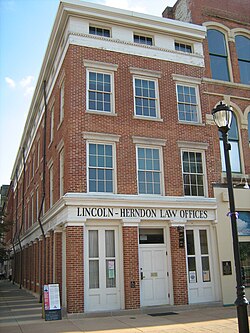
Springfield is the capital of the U.S. state of Illinois and the county seat of and most populous city in Sangamon County. The city's population was 114,394 at the 2020 census, which makes it the state's seventh most-populous city, the second largest outside of the Chicago metropolitan area, and the largest in central Illinois. Approximately 208,000 residents live in the Springfield metropolitan area.

Ward Hill Lamon was a personal friend and self-appointed bodyguard of U.S. President Abraham Lincoln. Lamon was famously absent the night Lincoln was assassinated at Ford's Theatre on April 14, 1865, having been sent by Lincoln to Richmond, Virginia.

Lincoln's New Salem State Historic Site is a reconstruction of the former village of New Salem in Menard County, Illinois, where Abraham Lincoln lived from 1831 to 1837. While in his twenties, the future U.S. President made his living in this village as a boatman, soldier in the Black Hawk War, general store owner, postmaster, surveyor, and rail splitter, and was first elected to the Illinois General Assembly.
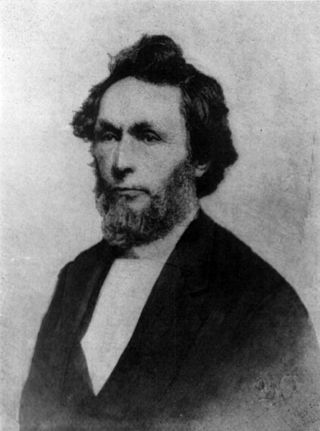
William Henry Herndon was a law partner and biographer of President Abraham Lincoln. He was an early member of the new Republican Party and was elected mayor of Springfield, Illinois.

The Abraham Lincoln Presidential Library and Museum documents the life of the 16th U.S. president, Abraham Lincoln, and the course of the American Civil War. Combining traditional scholarship with 21st-century showmanship techniques, the museum ranks as one of the most visited presidential libraries. Its library, in addition to housing an extensive collection on Lincoln, also houses the collection of the Illinois State Historical Library, founded by the state in 1889. The library and museum is located in the state capital of Springfield, Illinois, and is overseen as an agency of state government. It is not affiliated with the U.S. National Archives and its system of libraries.

Lincoln Home National Historic Site preserves the Springfield, Illinois home and related historic district where Abraham Lincoln lived from 1844 to 1861, before becoming the 16th president of the United States. The presidential memorial includes the four blocks surrounding the home and a visitor center.

The Illinois State Capitol, located in Springfield, Illinois, houses the legislative and executive branches of the government of the U.S. state of Illinois. The current building is the sixth to serve as the capitol building since Illinois was admitted to the United States in 1818. Built in the architectural styles of the French Renaissance and Italianate, it was designed by Cochrane and Garnsey, an architecture and design firm based in Chicago. Ground was broken for the new capitol on March 11, 1868, and the building was completed twenty years later for a total cost of $4.5 million.

Abraham Lincoln was born on February 12, 1809, in a one-room log cabin on the Sinking Spring farm, south of Hodgenville in Hardin County, Kentucky. His siblings were Sarah Lincoln Grigsby and Thomas Lincoln, Jr. After a land title dispute forced the family to leave in 1811, they relocated to Knob Creek farm, eight miles to the north. By 1814, Thomas Lincoln, Abraham's father, had lost most of his land in Kentucky in legal disputes over land titles. In 1816, Thomas and Nancy Lincoln, their nine-year-old daughter Sarah, and seven-year-old Abraham moved to what became Indiana, where they settled in Hurricane Township, Perry County, Indiana.
The Illinois Historic Preservation Division, formerly Illinois Historic Preservation Agency, is a governmental agency of the U.S. state of Illinois, and is a division of the Illinois Department of Natural Resources. It is tasked with the duty of maintaining State-owned historic sites, and maximizing their educational and recreational value to visitors or on-line users. In addition, it manages the process for applications within the state for additions to the National Register of Historic Places.
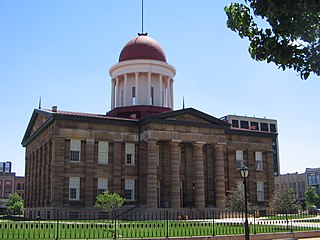
The Old State Capitol State Historic Site, in Springfield, Illinois, is the fifth capitol building built for the U.S. state of Illinois. It was built in the Greek Revival style in 1837–1840, and served as the state house from 1840 to 1876. It is the site of candidacy announcements by Abraham Lincoln in 1858 and Barack Obama in 2007. It was designated a National Historic Landmark in 1961, primarily for its association with Lincoln and his political rival Stephen Douglas.

The Vandalia State House, built in 1836, is the fourth capitol building of the U.S. state of Illinois. It is also the oldest capitol building in Illinois to survive, as the first, second, and third capitol buildings have all disappeared. The brick Federal style state house has been operated by the state of Illinois as a monument of Illinois' pioneer years since 1933. It is located in Vandalia, Illinois, on the National Road, and listed on the National Register of Historic Places.

The Mount Pulaski Courthouse State Historic Site is a historic county courthouse located in Mount Pulaski, Illinois, United States. It was the county seat of Logan County from 1848 until 1855. It is one of only two remaining courthouses from Illinois's Eighth Circuit, the circuit on which central Illinois lawyer Abraham Lincoln carried out much of his practice of law. The courthouse is operated by the Illinois Historic Preservation Agency as a state historic site. Visitors are given guided tours of the recreated county offices and courtroom.
The Postville Courthouse State Historic Site is a replica county courthouse in Lincoln, Illinois, United States. The original frame courthouse was built in 1840 and later moved to Greenfield Village in Michigan; the current courthouse, which is a close replica of the first, was built in 1953. The building's unusual history is derived from its status as one of the courthouses used by lawyer Abraham Lincoln as he traveled the circuit of courtrooms in central Illinois. The courthouse replica is operated by the Illinois Historic Preservation Agency.

The Metamora Courthouse State Historic Site is a historic American courthouse located in Metamora, Illinois, the former county seat of Woodford County. The courthouse was built in 1845 as the governmental center for Woodford County and as a circuit court for the former Illinois Eighth Circuit. The courthouse is best known for being one of only two surviving Illinois circuit courthouses where future U.S. President Abraham Lincoln practiced law.

David Logan was an American attorney and politician in the territory of and later state of Oregon. A native of Illinois, he moved to Oregon in 1850 where he served in the Oregon Territorial Legislature and in the Oregon Constitutional Convention. A founder of the Oregon Republican Party, he also served as mayor of Portland.
The Abraham Lincoln National Heritage Area is a National Heritage Area in central Illinois telling the story of Abraham Lincoln. A National Heritage Area is a federal-designated area intended to encourage historic preservation and an appreciation of the history and heritage of the site. While National Heritage Areas are not federally owned or managed, the National Park Service provides an advisory role and some technical, planning and financial assistance.
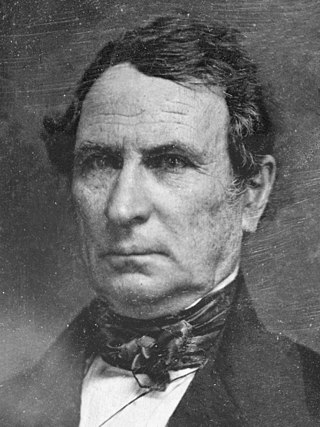
Justin Butterfield served in 1849–1852 as commissioner of the General Land Office of the United States. Appointed to this position in 1849 by the incoming Zachary Taylor administration, he is best known for having faced down, and defeated, another Whig candidate for the same job, Abraham Lincoln. In the General Land Office, he was one of the leading adopters of the railroad land grant system for financing the construction of long-distance railroad infrastructure throughout the United States. He was also one of the foremost Gentile defenders of the rights of the Church of Jesus Christ of Latter Day Saints in Illinois during the final period of Joseph Smith's leadership at Nauvoo.
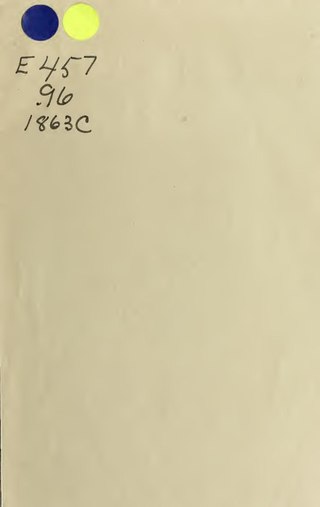
James Cook Conkling was an American politician and attorney from New York City. A graduate of Princeton College, Conkling was admitted to the bar, then moved to Springfield, Illinois. There, he became a prominent Whig, serving first as mayor and later in the Illinois House of Representatives. In 1856, he became one of the first Republicans in the state, attending the Bloomington Convention with Abraham Lincoln. Twice a presidential elector, Conkling was a State Agent during the Civil War and returned to the Illinois House in 1866. Later in his life he was a postmaster and a trustee of the University of Illinois.
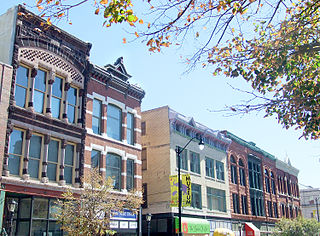
The Central Springfield Historic District is a 12-acre (4.9 ha) historic district in downtown Springfield. The district encompasses Springfield's oldest commercial district and is centered on the Old State Capitol. While the area was platted in 1822, only two buildings in the district predate the 1850s: the Old State Capitol and the Lincoln-Herndon Law Offices, both built in 1837. The majority of the district's buildings were constructed during Springfield's population boom in the 1860s and its subsequent growth in the latter half of the 19th century. These buildings included hotels, drug stores, groceries, clothing stores, and dry goods stores; some of the stores built in this period are still in operation. The businesses are also significant examples of 19th-century brick commercial architecture, including the Romanesque Pierick-Sommer Building and several works by prominent Springfield architects Helmle & Helmle.
